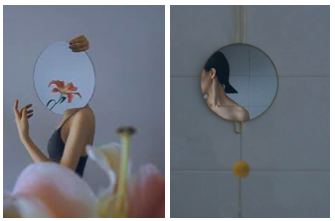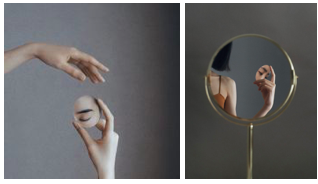By Lyka Peng, G11
(TW: body image, mention of eating disorders)

Beauty is like a diamond.
Translucent, clean cut, shiny, polished. It is valuable and extremely sought after. Beauty has the power to do anything – people praise and bow down to it like a God. We often have conversations about the human obsession with superficiality as a whole, but we don’t realise that it impacts us more personally than we think. Even though we might not want to admit it, it is no secret that we place it as our highest societal priority. We are not invincible to the feeling of wanting to fit in and be appreciated.
Nevertheless, it is difficult to break away from the norm — especially with the rise of digital media, where girls compare their physical selves with various influencers and models from very early on. Insecurities over body image and self-esteem become almost inevitable. At this day and age, they can only pretend to be indifferent to the expectations bestowed upon them.
Similarly to everywhere else in the world, being conventionally attractive is considered a massive privilege in Cambodian society. Even though it has progressed over the years, this is still primarily a country with conservative and traditionalist values. Women are expected to be good-looking, polite, domestic, and submissive to their husbands. Unfortunately, that is only the tip of an iceberg hiding a number of other factors Cambodian women have to live up to. An old saying goes where a woman has to be “ស្រីគ្រប់លក្ខណ៍”, literally translating to “a woman with all” or “a perfect woman.” Any other traits that stray from the benchmark definition of perfection are seen as a fault.
However, that goes without saying– visual aesthetics are an essential part of a woman’s role in the Cambodian society. In a lot of cases, women are simply reduced to their looks, as though they determine their entire lives. Some of the beauty standards that have been around since the beginning include femininity, slender body, and fair porcelain skin. This is associated with being of a higher class — more specifically, being shielded inside, away from the sun, as opposed to those who are in laborious jobs and spend more time in the heat. Of course, being ‘too skinny’ would also mean the individual is too poor to afford even the most basics of necessities. Furthermore, with the rise of East Asian media and Eurocentric beauty standards, double eyelids, big eyes, and a small face are seen as the epitome of beauty. This can be seen through the number of mixed race Cambodians or Wasians in general who often get fetishised because of how ‘exotic’ they are. Being described as Europeans, Korean, or Japanese would be considered a huge compliment. Other races or ethnicities with darker skin tones such as African or South Asian are typically not as appreciated. This shows how the image of the average Cambodian is so unwelcomed that they’d rather be an entirely different ethnicity to be viewed as pretty. These beauty standards are so rigid and specific that it almost seems as if they want exact replicas of each other, and because of how unrealistic and high the bar is set, Khmer women turn to various methods in order to alter their appearance.
With the current standards, anything over 50 kilograms regardless of height would be considered on the heavier side and ultimately, overweight. Therefore, many Cambodian women partake in an intense diet culture. They often starve themselves, skipping meals whenever they can. The diet methods are endless– sometimes eating as little as one boiled egg a day. They further encourage each other to follow these methods and it eventually becomes something resembling a chain reaction. Additionally, various weight loss supplements and dietary pills are on the market, constantly booming in sales. Having a slim figure is so glorified that being able to afford these things in the first place is considered an advantage. Corsets are also a popular clothing choice. Though diet culture is so common, there are not many concerns regarding eating disorders as issues regarding mental health are seen as taboo. Besides, women who are able to endure these rigorous diet plans are applauded for their perseverance and are seen as capable of taking care of themselves.
The extremes that women would go through in order to make themselves appear more fair is terrifying in itself. At its most modest form, Cambodian society pushes women to buy cosmetics many shades lighter than their own skin tone to cover what’s underneath. The white cast that most of this style of makeup results in is actually not a deal breaker at all, as opposed to Western makeup, where everything has to be blended. However, whitening creams and skin bleaching has always been a classic method to abide by the conventional beauty standards. It is advertised everywhere– from big commercial brands, such as Vaseline, to small local shops. There are various ‘lotion’ stores all throughout the country as well as online, where various formulas and chemicals are hand-mixed together to create a lightening effect. Scrubs are also a popular choice in an attempt to get rid of darker skin tones. If they have the means, women will even undergo forms of cosmetic procedure to permanently lighten their skin to achieve their desired fairness.
Body shaming
(noun)
The act or practice of subjecting someone to criticism or mockery for supposed bodily faults or imperfections. (Merriam Webster dictionary)
Most importantly, body shaming is incredibly prevalent and normalised in Cambodian society. It is so integrated into everyday life that it becomes a mere greeting. Instead of addressing someone with a simple hello, comments such as “Did you gain weight?” or “You’re definitely darker than the last time I met you,” arise. Cambodian girls and women are already so desensitised to these remarks that they don’t even think much of it at all, even if they are made by strangers. For parents and/or other relatives, this is essentially a form of ‘tough love’. Lines often heard regarding these statements would be “Because I care about you and your health” or “You need to look presentable and not lose face.” It is often worded in a way that waters down the overall hidden message – that they are not happy with the way their child looks.
Body shaming also allows room for unnecessary comparisons and further competition over who is the most conventionally attractive person. The age when little girls first feel insecure about their bodies seem to drop lower and lower each year as beauty standards build in importance. This then leads to various consequences that makes them feel worse. One example would be a domino-like effect: girls spend time on their appearance because of their low self-esteem, but then are told that they are too high-maintenance or too materialistic. They tone it down, and again they are faced with other statements referring to how they are lazy and don’t care about themselves. Whatever it is, it seems to be a cycle that never stops.

“Beauty is in the eye of the beholder.”
It is crucial to truly perceive just how diverse beauty is. Some might argue that because Cambodia is a homogenous country, the beauty standard should not be as open. However, the concept of attractiveness cannot be properly defined as everyone has their own idea of what it should look like, therefore sticking to a conventional beauty standard just pushes the narrative that everyone has to be the same way. Others are just simply in denial of the fact that beauty comes in so many different forms and is not objective or set in stone according to a certain appearance. If we abolish the idea of beauty being a one-size-fits-all concept, then no one would need to feel burdened by ‘conventions’ that can’t be applicable to everyone in the first place. Cambodian women need to realise that they don’t need to be anyone else but themselves. A woman should not feel beautiful solely because of her visual appearance. A woman should feel beautiful simply for existing.
![]()

